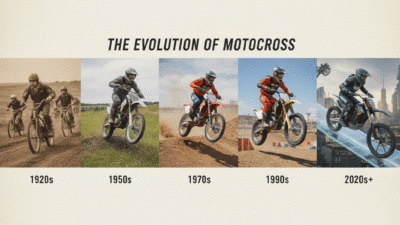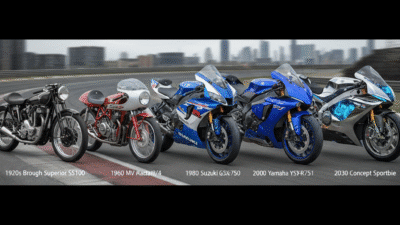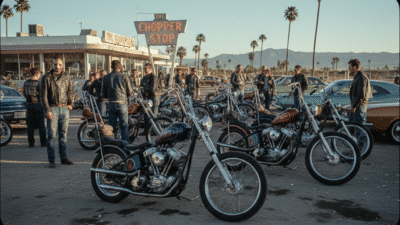From rudimentary contraptions sputtering to life over a century ago to the screaming, carbon-fiber marvels that electrify circuits worldwide today, the journey of the evolution of motorcycle racing is a tale of relentless innovation, breathtaking courage, and an unquenchable thirst for speed. It’s a saga etched in grit, oil, and triumph, chronicling how two wheels and an engine transformed into a global spectacle. So, rev your engines and prepare for a high-octane ride through history, as we trace the incredible transformation of motorcycle racing from its humble beginnings to the high-tech arena it is today.
The Spark of Speed: Early Days and Pioneering Spirits
Imagine a time before dedicated race tracks, before specialized tires, and certainly before sophisticated suspension. This was the raw, untamed dawn of motorcycle racing. It all began in the late 19th century, not long after the invention of the internal combustion engine and its first successful mounting onto a bicycle frame. These early machines were crude by today’s standards – essentially motorized bicycles, heavy, unwieldy, and often more prone to breaking down than to setting speed records.

The first “races” were less about outright speed and more about proving reliability and endurance. Picture gentlemen in tweed and leather helmets, battling not just each other, but also rudimentary roads, unpredictable mechanics, and the sheer challenge of keeping their temperamental machines running. Events like the Paris-Bordeaux-Paris trial in 1895, though primarily for cars, saw early motorcycle entries, hinting at the competitive spirit that would soon ignite.
By the turn of the 20th century, purpose-built motorcycles, or at least heavily modified production bikes, began to appear. Manufacturers quickly realized that success on the race track translated directly into sales in the showroom. This competitive drive fueled rapid advancements in engine design and chassis development. If you’re curious about how these powerplants first took shape, you can dive deeper into the evolution of early motorcycle engines. These pioneers, often engineers and riders rolled into one, laid the foundation for everything we see today.
The most iconic early race, and one that still holds immense prestige, is the Isle of Man TT (Tourist Trophy). First run in 1907, it wasn’t just a race; it was an extreme test of rider skill, machine endurance, and sheer bravery on public roads. The Snaefell Mountain Course, with its terrifying bends, elevation changes, and proximity to stone walls, quickly became the ultimate proving ground, attracting fearless riders and pushing engineers to their limits. This era was defined by the raw, visceral challenge of man and machine against the clock and the road.

The Interwar Boom and Post-War Renaissance: Specialization Takes Hold
The period between the World Wars saw significant leaps forward for motorcycle racing. While early racing bikes were often stripped-down road machines, the demand for greater speed and handling led to increasingly specialized designs. Engines became more powerful, frames lighter yet stronger, and primitive suspension systems began to appear, offering a modicum of comfort and control.
World War I, surprisingly, played a role in accelerating motorcycle development. Motorcycles were extensively used for reconnaissance and communication, leading to robust designs and an understanding of their mechanical limitations under duress. This knowledge, once the war ended, filtered back into civilian production and, naturally, into racing. Similarly, World War II also saw significant roles for motorcycles, and their innovations in military use continued to inform racing technology (for a fascinating look, check out how motorcycles during World War I and motorcycles in World War II impacted their development).
By the 1920s and 30s, national championships were flourishing, and the concept of Grand Prix racing began to take shape across Europe. Events in places like Monza, Spa-Francorchamps, and the Nürburgring became hallowed grounds for racers. Big names like Norton, Velocette, AJS, and BMW dominated, showcasing their engineering prowess. Riders became celebrated heroes, pushing the boundaries of what was thought possible on two wheels. Speeds continued to climb, and while safety measures were still minimal, the spectacle was undeniable.
Pros and Cons
| Pros | Cons |
|---|---|
| – Rapid Technological Advancement: Competition fuels innovation in engines, chassis, tires, and aerodynamics, benefiting road bikes too. | – High Risk of Injury/Fatality: Despite advancements, it remains a dangerous sport for riders. |
| – Unrivaled Spectacle & Entertainment: High-speed action, close overtakes, and daring maneuvers captivate audiences globally. | – Expensive to Participate: Professional racing demands significant financial investment in machinery, teams, and logistics. |
| – Human-Machine Synergy: Pushes the limits of rider skill, physical endurance, and mental fortitude. | – Environmental Concerns: Noise and emissions (though electric racing is addressing this). |
| – Strong Community & Passion: Fosters a vibrant global community of fans, riders, and enthusiasts. | – Dependence on Sponsorship: Teams and riders heavily rely on corporate funding, which can be volatile. |
| – Testing Ground for Road Technology: Many safety and performance features on consumer motorcycles originate from racing R&D. |
The Golden Era: 1950s-1970s – Legends, Power, and Peril
The post-war boom ushered in what many consider the “Golden Era” of motorcycle racing. The FIM (Fédération Internationale de Motocyclisme) established the Grand Prix World Championship in 1949, setting the stage for what would become MotoGP. This period saw an explosion of technological innovation, particularly from Japanese manufacturers who entered the scene with a fierce determination to win.
Honda, Yamaha, Suzuki, and Kawasaki challenged the European dominance of MV Agusta, Norton, and Gilera. Multi-cylinder engines, often with intricate engineering, became the norm, pushing horsepower figures to unprecedented levels. Frames evolved, suspension systems improved dramatically, and tire technology became a critical area of development, allowing riders to lean further and carry more speed through corners.
This era produced some of the most revered names in the sport: Giacomo Agostini, Mike Hailwood, Phil Read, Barry Sheene, and Kenny Roberts Sr. These riders became global superstars, their rivalries legendary, their styles iconic. Agostini, with 15 world titles, remains one of the most successful riders in history. These were riders who danced on the edge, pushing machines that, while powerful, were still notoriously difficult to handle. The circuits, many of them public roads, were incredibly dangerous, leading to a high toll of injuries and fatalities. It was a time of immense passion, daring, and raw, unfiltered racing.
The Modern Age: 1980s-2000s – Technology Takes the Helm
The 1980s and 90s witnessed the two-stroke engine’s zenith in Grand Prix racing. Machines like the 500cc two-strokes, producing incredible power-to-weight ratios, demanded immense skill and bravery to control. They were often described as “widow makers” due to their explosive power delivery and brutal nature. Aerodynamics started playing a more significant role, with designers sculpting fairings to cheat the wind and provide stability at ever-increasing speeds.
Chassis technology, particularly with aluminum twin-spar frames, became highly advanced, offering unprecedented rigidity and feedback. Suspension components, such as inverted forks and sophisticated rear shocks, allowed for finer tuning and better control over various track conditions. Tire manufacturers invested heavily in research and development, creating compounds that offered astonishing grip.
This era also saw the rise of World Superbike (WSBK) racing, which debuted in 1988. Unlike the prototype machines of Grand Prix racing, WSBK featured highly modified production-based motorcycles, making it more relatable to enthusiasts. It quickly gained popularity, showcasing the capabilities of bikes you could buy (albeit highly tuned versions). This period also marked a significant shift from racing predominantly on modified public roads to purpose-built circuits like Silverstone, which became a home for British motorsport and others, designed with greater safety in mind.
It was also during this time that the first inklings of electronic aids began to surface. Traction control, though primitive, started appearing, hinting at the digital revolution that would soon transform the sport. These advancements were laying the groundwork for the incredibly sophisticated machines we see on track today. For a deep dive into how electronics transformed the sport, explore MotoGP’s evolution of electronic aids.

MotoGP and World Superbike: The Pinnacle of Two-Wheeled Competition
Today, the pinnacle of motorcycle racing is undoubtedly shared between MotoGP and World Superbike. While both showcase incredible speed and talent, there’s a fundamental difference. MotoGP features purpose-built prototype machines, meaning manufacturers design and build every component from scratch solely for racing. These bikes are technological masterpieces, unconstrained by production rules, pushing the absolute limits of engineering.
World Superbike, on the other hand, uses highly modified production bikes. These are machines you can buy from a dealership, albeit stripped down, tuned, and fitted with race-specific components. This makes WSBK feel more “accessible” and showcases the performance potential of consumer motorcycles. If you’ve ever wondered about the nitty-gritty distinctions, a good resource for understanding MotoGP vs. World Superbike: What’s the Difference? is available.
Modern MotoGP bikes are engineering marvels. They feature advanced carbon fiber chassis, incredible aerodynamic wings (often referred to as ‘aero fairings’) that generate downforce, and sophisticated electronic packages that manage everything from traction control and anti-wheelie to launch control and engine braking. These electronic brains are crucial for taming the bikes’ immense horsepower, which can exceed 250hp from 1000cc four-stroke engines.
The riders are athletes of the highest caliber, combining immense physical strength, mental fortitude, and superhuman reflexes. The “alien” era of Valentino Rossi, Casey Stoner, Jorge Lorenzo, and Marc Marquez showcased a level of riding skill that often defied logic. They push these machines to their absolute limits, reaching speeds over 350 km/h (217 mph) and cornering with lean angles that seem impossible, often scraping elbows and shoulders on the asphalt.
Beyond the Track: Off-Road, Endurance, and Electric Racing
While Grand Prix racing captures many headlines, the world of motorcycle racing is incredibly diverse. Off-road disciplines like Motocross and Supercross offer spectacular aerial maneuvers and intense bar-to-bar action on dirt tracks. Enduro racing tests endurance and navigation over varied, often challenging terrain. Speedway is a unique, short-track discipline where bikes slide sideways without brakes, and the Dakar Rally is the ultimate off-road endurance challenge, pitting man and machine against thousands of kilometers of brutal deserts and unforgiving landscapes. If you’re intrigued by the latter, exploring the Dakar Rally: An Off-Road Adventure provides a thrilling overview.
The evolution doesn’t stop there. Endurance racing, such as the Suzuka 8 Hours or the Bol d’Or, pushes teams and riders to the absolute limit over extended periods, highlighting reliability as much as speed. It’s a true test of a machine’s durability and a team’s strategy.
Perhaps the most exciting development on the horizon is the rise of electric motorcycle racing. Series like MotoE, the electric support class for MotoGP, are proving that electric bikes can deliver exhilarating performance and intense competition. While still in its early stages, electric racing is a critical testbed for sustainable technologies that will undoubtedly influence future road bikes. For an insightful look into this burgeoning field, read more about electric motorcycles in competitive racing. The silence of these machines on track is a stark contrast to their petrol-powered counterparts, yet the speed and drama remain. This represents a significant step towards a more environmentally conscious future for motorsports.

Safety First: The Evolution of Rider Protection
The progression of motorcycle racing wouldn’t be complete without acknowledging the monumental strides made in rider safety. In the early days, riders wore little more than tweed suits, rudimentary leather caps, and perhaps some basic leather gloves. Fatalities and severe injuries were a tragic, common occurrence.
Over the decades, safety has become a paramount concern, driven by rider advocacy, technological advancements, and a better understanding of crash dynamics. The evolution of the racing helmet is a prime example. From simple leather bowls to the multi-layered, aerodynamic carbon-fiber shells we see today, helmets are engineered to absorb massive impacts and protect the most vulnerable part of the rider. For a fascinating look at this journey, delve into the evolution of racing helmets.
Beyond helmets, rider gear has transformed. Full-body leather suits, once basic protection, now incorporate advanced materials, CE-approved armor at critical joints, and integrated airbag systems that deploy upon impact, offering vital protection to the torso and neck. Boots provide ankle and shin protection, while gloves guard hands and wrists.
Track design has also been revolutionized. Modern circuits feature extensive run-off areas, air fences, and gravel traps to slow riders and bikes down safely in a crash. Medical facilities at race tracks are state-of-the-art, with highly trained teams on standby to provide immediate assistance. The commitment to rider safety is a testament to the sport’s maturity, allowing riders to push the limits with a greater degree of confidence.

Conclusion: A Legacy of Speed, Skill, and Innovation
The evolution of motorcycle racing is a gripping narrative of human ingenuity and unyielding passion. From the pioneering spirits wrestling with rudimentary machines on dusty roads to the modern gladiators taming 250hp prototypes with surgical precision, the core essence of the sport remains: the relentless pursuit of speed and the ultimate test of man and machine.
It’s a story told through the roar of engines, the blur of colors, and the sheer audacity of riders who defy gravity and push boundaries. It’s a testament to how competition drives innovation, leading to advancements that benefit not just racers, but also everyday motorcyclists. As technology continues to evolve, from sustainable fuels to even more sophisticated electronics and materials, the future of motorcycle racing promises to be just as thrilling and unpredictable as its past.
So, whether you’re a long-time fan or a curious newcomer, take a moment to appreciate the incredible journey that motorcycle racing has undertaken. It’s more than just a sport; it’s a vibrant, ever-changing spectacle that continues to captivate hearts around the globe. Get ready for the next chapter – the bikes are faster, the riders are braver, and the pursuit of glory is eternal.
Frequently Asked Questions
What was the first major motorcycle race?
While informal races existed earlier, the Isle of Man Tourist Trophy (TT) race, first held in 1907, is widely considered the first major and most prestigious motorcycle race, still running today.
How have motorcycle racing engines evolved?
Early racing bikes used single-cylinder engines, often derived from road bikes. Over time, engines evolved to include multi-cylinder designs (twin, four, six-cylinders), initially two-stroke, then predominantly four-stroke in modern Grand Prix racing, featuring advanced fuel injection and electronic management systems.
What is the main difference between MotoGP and World Superbike?
MotoGP features purpose-built prototype racing machines that are not available for public sale, designed from the ground up for racing. World Superbike (WSBK) uses highly modified production motorcycles, meaning they are based on bikes you can buy from a dealership, albeit heavily tuned for competition.
How has rider safety improved over the years?
Rider safety has seen immense improvements, evolving from basic leather caps and rudimentary gear to advanced full-body leather suits with integrated armor and airbags, sophisticated multi-layered carbon fiber helmets, and safer track designs with extensive run-off areas and protective barriers.
Are electric motorcycles involved in competitive racing?
Yes, electric motorcycles are now actively involved in competitive racing, most notably with the FIM MotoE World Championship, which serves as a support class for MotoGP. This series showcases the potential of electric two-wheeled performance and contributes to the development of sustainable racing technology.
What role did World Wars play in motorcycle development?
Both World War I and World War II accelerated motorcycle development. Their use in military roles for reconnaissance and communication led to more robust designs and highlighted areas for mechanical improvement, knowledge which later flowed back into civilian and racing motorcycle engineering.



